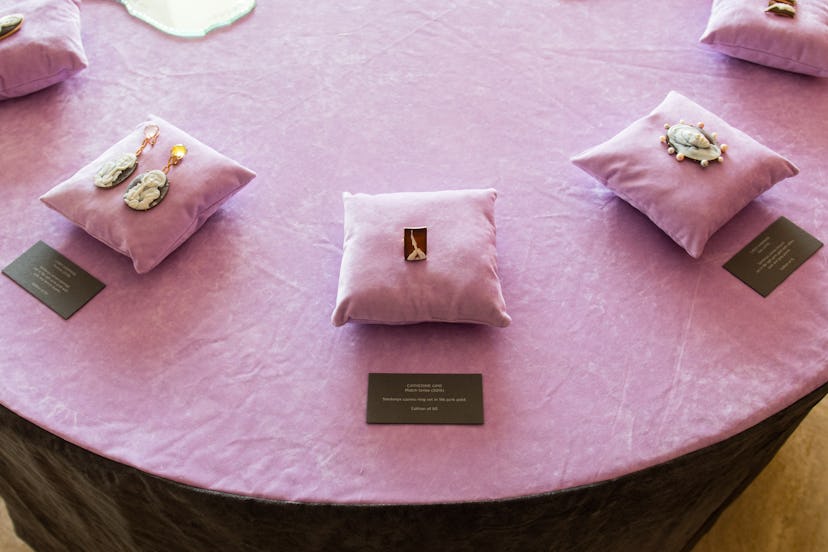Cindy Sherman and Catherine Opie Make a Strangely Charming Cameo in Jewelry Together
The artists explain their new limited edition line with Lizworks at the Venice Biennale launch.

Last week, the 58th Venice Biennale kicked off with art exhibitions around the ancient city. And on the quiet island of Giudecca, there was a jewelry launch—a group of women huddled over a table; one held up an oval necklace with an unlikely image: a woman breastfeeding.
The necklace was based on a photographic self-portrait by the Los Angeles artist Catherine Opie, as part of the limited edition line Cameo, by Lizworks, which launched in Venice alongside new pieces by Cindy Sherman.
“It’s giving it a new dimension and a new voice to cameos,” said the company’s founder, Liz Swig, at the event. “To bring both of their works into 3D sculpture through 16th century art history, what could be better?”
Cindy Sherman, Liz Swig, and Catherine Opie in Venice.
The history of cameos dates back to the 15th century, when women wore decorative charms to depict beloved family members or to send subtle messages to potential suitors (some women would wear a symbol of Eros, as a seduction tactic). Napoleon, who wore a cameo on his wedding day, also founded a carving school for cameo-makers in Paris. All of the cameos created with Lizworks are handcrafted in the south of Italy by a traditional cameo-maker, Gino di Luca. The Cameo line includes pink gold necklaces, cufflinks, and rings with sapphire, rubies, and pearls. They all bend the idea of traditional cameos just enough.
“My nursing self-portrait is like the Madonna and Child, but at the same time, you see a 40-year-old lesbian with tattoos who had a baby,” said Opie. “In a certain way, you can take the motif and push it to another place, so it has another iconography to it.”
“That’s what I tried to bring to the cameos,” she went on. “Here’s this history, but how can we have a different conversation with that piece of history?”
A Cameo piece by Catherine Opie.
The idea was hatched when Swig saw Opie’s portraits at the Thomas Dane Gallery in London, where she photographed Anish Kapoor, Rick Owens. and Michele Lamy in oval-shaped frames. “I was like, Why does every photograph have to be a rectangle or a square?” Opie said of those works. “I knew my portraiture lent itself to the history of cameos, but how do you make it more contemporary?”
Among Opie’s cameo pieces is a brooch featuring her son Oliver and a ring with a lit match. She also created a pair of cufflinks with a tree stump she photographed at Edvard Munch’s home in Norway.
“I love that history, that conversation with art,” she said. “I put the axe in the stump; I thought it was the butch thing to do. I wear suits, shirts with cufflinks at times. I wanted a butch cool pair of cufflinks for myself.”
Catherine Opie’s Cameo cufflinks.
Sherman’s pieces are modeled after her Instagram selfies, including one she calls “Spa,” where she wears a towel on her head. “I like cameos, especially the idea of dark, strange ones,” said Sherman. “It seemed like a good project for using my Instagram images, since the files aren’t large enough files to blow up into photographs, and they also concentrate on being mainly portraits.”
For Opie, they’re personal relics, visual tokens from her own personal diary. “They’re intimate stories about my life,” she said. “I wanted people to wear it—from my body to their body.”
Cindy Sherman’s Cameo earrings.